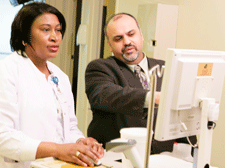Cardiovascular Risk Registry Now Available in All HHC Hospitals
Jun 30, 2009

The New York City Health and Hospitals Corporation has established a new Cardiovascular Risk Registry, an electronic disease-tracking program that greatly improves doctors’ ability to understand, monitor, and manage heart disease risk among patients.
Medical staff at HHC facilities were given access to the registry on May 1, which will allow them to track patients’ hypertension and hypercholesterolemia – high blood pressure and high blood cholesterol – which are leading causes of heart disease, stroke, and other vascular conditions. Doctors, nurses and other health care providers will be able to use this information to better monitor and coordinate care helping patients achieve healthy hearts.
“As we have done successfully these past two years with diabetes, HHC once again is using its advanced clinical information technology to drive the more effective management of two other prevalent chronic diseases that severely impact the long term health status of whole communities, as well as the long term healthcare costs for our society at large,” said HHC President Alan Aviles.
Hypertension is a chronic disease in which the blood pressure remains above the normal value of 120/80. It can harm the arteries and causes an increase in the risk of stroke, heart attack, kidney failure and blindness. Hypertension affects 1 in 3 adults in the U.S. — about 30% of whom are undiagnosed. According to the NYC Department of Health, nearly a third of black New Yorkers report high blood pressure, compared with 22% of whites. Death rates from hypertension are more than 3 times higher in New York City’s poorest neighborhoods than in the wealthiest.
High cholesterol is a condition that contributes to arteriosclerosis, heart attack and stroke. In New York City, heart disease is the #1 cause of death regardless of race or ethnicity and for both men and women. Stroke is the 5th leading cause of death. Heart disease and stroke are two of the most common diseases that make up cardiovascular disease.
Already there are 42,309 HHC patients enrolled in the cardiovascular risk registry. Patients enrolled in the registry must be older than 18 and younger than 75. They must have been seen as patients at an HHC primary care facility within the last 12 months. And they must have a diagnosis of hypertension and/or hypercholesterolemia. Patients with diabetes and hypertension are monitored in our separate diabetes registry. By mining through HHC’s electronic patient records data, the risk registry has already been able to identify more than 26,000 patients with hypercholesterolemia and more than 42,000 with hypertension.
Melissa Schori, MD, MBA, Medical Director at Lincoln Medical and Mental Health Center, noted, “This registry will make a difference in the quality of life of patients with poorly controlled BP and cholesterol. They will benefit from closer management by their primary care physician, gaining knowledge of their condition and self management tools. Similarly, this technology allows providers to leverage the electronic medical record to better manage the health outcomes of a targeted group of patients with the goal of reducing the morbidity and mortality associated with cardiovascular disease.”
The cardiovascular risk registry is the latest example of HHC’s strategy of using powerful database software to identify at-risk patients in the vast haystack of data stored in its advanced electronic medical records system. HHC pioneered the use of this technique with its electronic registry for patients with diabetes and has seen a significant increase in the number of diabetic patients who have achieved healthy levels of blood sugar, blood pressure and cholesterol — the three leading indicators for the disease. The registry allows clinical teams to tailor medication regimens and better support self-management efforts for more than 50,000 New Yorkers with diabetes.
With the risk registry, clinicians and administrators can ensure that all these patients get the care they need, while also using the registry’s data-analysis features to further improve the hospital system’s evidence-based prevention and treatment strategies. The Corporation expects to be able to study and measure the impact of the CRR in the next 9 to 12 months.
Contact: Ian Michaels (HHC) (212) 788-3339.
About HHC
The New York City Health and Hospitals Corporation (HHC) is a $6.7 billion integrated healthcare delivery system with its own 420,000 member health plan, MetroPlusHealth, and is the largest municipal healthcare organization in the country. HHC serves 1.4 million New Yorkers every year and more than 475,000 are uninsured. HHC provides medical, mental health and substance abuse services through its 11 acute care hospitals, five skilled nursing facilities, six large diagnostic and treatment centers and more than 70 community based clinics. HHC Health and Home Care also provides in-home services for New Yorkers. HHC was the 2008 recipient of the National Quality Forum and The Joint Commission’s John M. Eisenberg Award for Innovation in Patient Safety and Quality. For more information, visit www.nychhc.org/hhc or find us on facebook.com/NYCHealthSystem or twitter.com/NYCHealthSystem.